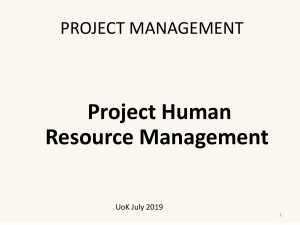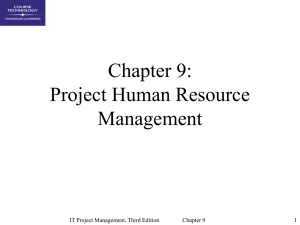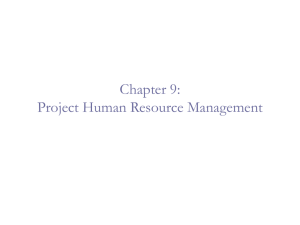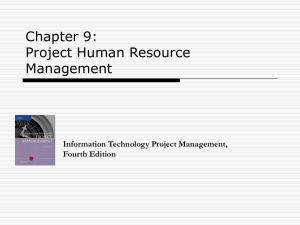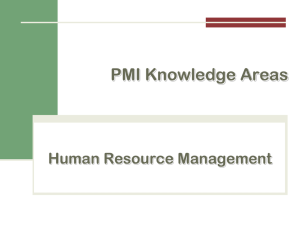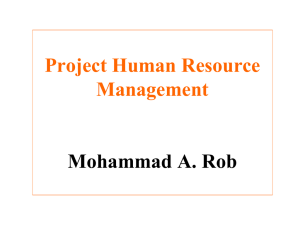Project HR Management
advertisement
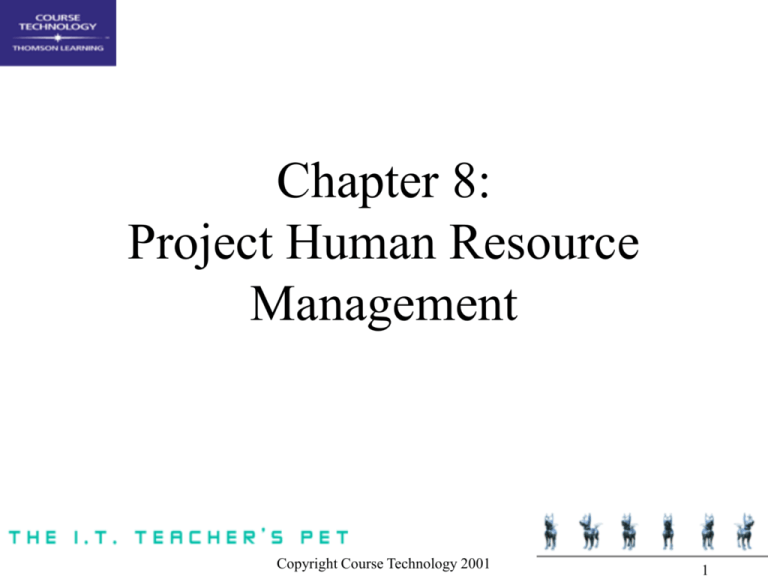
Chapter 8: Project Human Resource Management Copyright Course Technology 2001 1 The Importance of Human Resource Management • People determine the success and failure of organizations and projects • Despite the downturn in the economy in 2001, there is still a shortage of good IT workers – ITAA calculated that there were over 844,000 openings for IT jobs in 2000 – 1 in 14 American workers are involved in IT jobs – Although women represent 47 percent of the work force, they make up only 29 percent of IT jobs Copyright Course Technology 2001 2 Long Hours and Stereotypes of IT Workers Hurt Recruiting • Many people are struggling with how to increase the IT labor pool. Noted problems include – The fact that many IT professionals work long hours and must constantly stay abreast of changes in the field – Undesirable stereotypes that keep certain people away from the career field, like women – The need to improve benefits, redefine work hours and incentives, and provide better human resource management Copyright Course Technology 2001 3 What is Project Human Resource Management? • Project human resource management includes the processes required to make the most effective use of the people involved with a project. Processes include – Organizational planning – Staff acquisition – Team development Copyright Course Technology 2001 4 Keys to Managing People • Psychologists and management theorists have devoted much research and thought to the field of managing people at work • Important areas related to project management include – motivation – influence and power – effectiveness Copyright Course Technology 2001 5 Motivation • Abraham Maslow developed a hierarchy of needs to illustrate his theory that people’s behaviors are guided by a sequence of needs • Maslow argued that humans possess unique qualities that enable them to make independent choices, thus giving them control of their destiny Copyright Course Technology 2001 6 Figure 8-1. Maslow’s Hierarchy of Needs Copyright Course Technology 2001 7 Herzberg’s Motivational and Hygiene Factors • Frederick Herzberg wrote several famous books and articles about worker motivation. He distinguished between – motivational factors: achievement, recognition, the work itself, responsibility, advancement, and growth, which produce job satisfaction – hygiene factors: cause dissatisfaction if not present, but do not motivate workers to do more. Examples include larger salaries, more supervision, and a more attractive work environment Copyright Course Technology 2001 8 McGregor’s Theory X and Y • Douglas McGregor popularized the human relations approach to management in the 1960s • Theory X: assumes workers dislike and avoid work, so managers must use coercion, threats and various control schemes to get workers to meet objectives • Theory Y: assumes individuals consider work as natural as play or rest and enjoy the satisfaction of esteem and self-actualization needs • Theory Z: introduced in 1981 by William Ouchi and is based on the Japanese approach to motivating workers, emphasizing trust, quality, collective decision making, and cultural values Copyright Course Technology 2001 9 Thamhain and Wilemon’s Ways to Have Influence on Projects 1. Authority: the legitimate hierarchical right to issue orders 2. Assignment: the project manager's perceived ability to influence a worker's later work assignments 3. Budget: the project manager's perceived ability to authorize others' use of discretionary funds 4. Promotion: the ability to improve a worker's position 5. Money: the ability to increase a worker's pay and benefits 6. Penalty: the project manager's ability to cause punishment 7. Work challenge: the ability to assign work that capitalizes on a worker's enjoyment of doing a particular task 8. Expertise: the project manager's perceived special knowledge that others deem important 9. Friendship: the ability to establish friendly personal relationships between the project manager and others Copyright Course Technology 2001 10 Ways to Influence that Help and Hurt Projects • Projects are more likely to succeed when project managers influence with – expertise – work challenge • Projects are more likely to fail when project managers rely too heavily on – authority – money – penalty Copyright Course Technology 2001 11 Power • Power is the potential ability to influence behavior to get people to do things they would not otherwise do • Types of power include – – – – – Coercive Legitimate Expert Reward Referent Copyright Course Technology 2001 12 Improving Effectiveness Covey’s 7 Habits • Project managers can apply Covey’s 7 habits to improve effectiveness on projects – – – – – – – Be proactive Begin with the end in mind Put first things first Think win/win Seek first to understand, then to be understood Synergize Sharpen the saw Copyright Course Technology 2001 13 Empathic Listening and Rapport • Good project managers are empathic listeners; they listen with the intent to understand • Before you can communicate with others, you have to have rapport • Mirroring is a technique to help establish rapport • IT professionals often need to develop empathic listening and other people skills to improve relationships with users and other stakeholders Copyright Course Technology 2001 14 Improving Relationships Between Users and Developers • Some organizations require business people, not IT people, to take the lead in determining and justifying investments in new computer systems • CIOs push their staff to recognize that the needs of the business must drive all technology decisions • Some companies reshape their IT units to look and perform like consulting firms Copyright Course Technology 2001 15 Organizational Planning • Organizational planning involves identifying, documenting, and assigning project roles, responsibilities, and reporting relationships • Outputs and processes include – – – – project organizational charts work definition and assignment process responsibility assignment matrixes resource histograms Copyright Course Technology 2001 16 Figure 8-2. Sample Organizational Chart for a Large IT Project Copyright Course Technology 2001 17 Figure 8-3. Work Definition and Assignment Process Copyright Course Technology 2001 18 Figure 8-4. Sample Responsibility Assignment Matrix (RAM) Copyright Course Technology 2001 19 Figure 8-5. RAM Showing Stakeholder Roles Copyright Course Technology 2001 20 Figure 8-6. Sample Resource Histogram for a Large IT Project 12 Number of People 10 8 6 4 2 0 Jan Feb Mar Apr May Java programmers Managers Testing specialists Jun Jul Aug Business analysts Administrative staff Copyright Course Technology 2001 Sep Oct Nov Dec Technical writers Database analysts 21 Staff Acquisition • Staffing plans and good hiring procedures are important in staff acquisition, as are incentives for recruiting and retention • Some companies give their employees one dollar for every hour a new person they helped hire works • Some organizations allow people to work from home as an incentive • Research shows that people leave their jobs because they don’t make a difference, don’t get proper recognition, aren’t learning anything new, don’t like their coworkers, and want to earn more money Copyright Course Technology 2001 22 Resource Loading and Leveling • Resource loading refers to the amount of individual resources an existing project schedule requires during specific time periods • Resource histograms show resource loading • Over-allocation means more resources than are available are assigned to perform work at a given time Copyright Course Technology 2001 23 Figure 8-6. Sample Resource Histogram for a Large IT Project Copyright Course Technology 2001 24 Figure 8-7. Sample Histogram Showing an Overallocated Individual Copyright Course Technology 2001 25 Resource Leveling • Resource leveling is a technique for resolving resource conflicts by delaying tasks • The main purpose of resource leveling is to create a smoother distribution of resource usage and reduce overallocation Copyright Course Technology 2001 26 Figure 8-8. Resource Leveling Example Copyright Course Technology 2001 27 Team Development • It takes teamwork to successfully complete most projects • Training can help people understand themselves, each other, and how to work better in teams • Team building activities include – physical challenges – psychological preference indicator tools Copyright Course Technology 2001 28 Meyers-Briggs Type Indicator (MBTI) • MBTI is a popular tool for determining personality preferences and helping teammates understand each other • Four dimensions include: – – – – Extrovert/Introvert (E/I) Sensation/Intuition (S/N) Thinking/Feeling (T/F) Judgment/Perception (J/P) • NTs or rationals are attracted to technology fields • IT people vary most from the general population in not being extroverted or sensing Copyright Course Technology 2001 29 Social Styles Profile • People are perceived as behaving primarily in one of four zones, based on their assertiveness and responsiveness: – – – – Drivers Expressives Analyticals Amiables • People on opposite corners (drivers and amiables, analyticals and expressives) may have difficulties getting along Copyright Course Technology 2001 30 Figure 8-9. Social Styles Copyright Course Technology 2001 31 Reward and Recognition Systems • Team-based reward and recognition systems can promote teamwork • Focus on rewarding teams for achieving specific goals • Allow time for team members to mentor and help each other to meet project goals and develop human resources Copyright Course Technology 2001 32 General Advice on Teams • Focus on meeting project objectives and producing positive results • Fix the problem instead of blaming people • Establish regular, effective meetings • Nurture team members and encourage them to help each other • Acknowledge individual and group accomplishments Copyright Course Technology 2001 33 Using Software to Assist in Human Resource Management • Software can help in producing RAMS and resource histograms • Project management software includes several features related to human resource management such as – viewing resource usage information – identifying under and over-allocated resources – leveling resources Copyright Course Technology 2001 34 Figure 8-10. Resource Usage View from Microsoft Project Copyright Course Technology 2001 35 Figure 8-11. Resource Usage Report from Microsoft Project Copyright Course Technology 2001 36 Project Resource Management Involves Much More Than Using Software • Project managers must – Treat people with consideration and respect – Understand what motivates them – Communicate carefully with them • Goal is to enable project team members to deliver their best work Copyright Course Technology 2001 37
